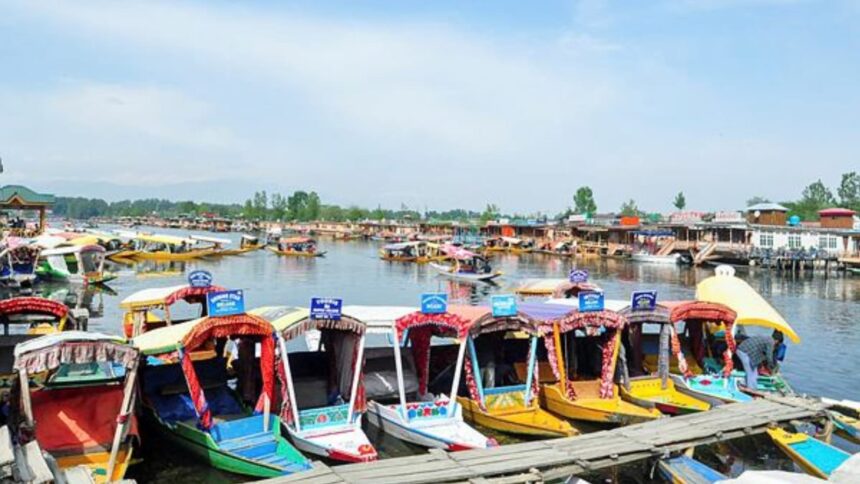With the tourist sector contributing 7 per cent to Jammu and Kashmir’s overall gross state domestic product, the state was banking big on tourism in the coming years, pegging hopes on years of relative peace to realise the region’s potential.
The term “tourism” featured as many as 27 times in Chief Minister Omar Abdullah’s March 7 speech for 2025-26, when he went on to declare that his government’s goal was to increase the sector’s contribution to J&K’s GSDP from 7 per cent to at least 15 per cent over the next four to five years as the state embarked on a “transformational journey to becoming a global tourism powerhouse”.
The terror attack in Pahalgam and the subsequent closure of 49 prominent have dashed those hopes.
The J&K Economic Survey for FY25 had pegged the nominal GSDP at Rs 2.65 lakh crore and the real GSDP at Rs 1.45 lakh crore. At 7 per cent of GSDP, the size of J&K’s tourism sector comes to Rs 18,550 crore in nominal terms and Rs 10,150 crore in real terms.
For neighbouring Himachal Pradesh, too, tourism accounts for nearly 8 per cent of the hill state’s GSDP. In that context, J&K’s aim to more than double tourism’s share in its GSDP within five years was an ambitious target.
For FY26, the J&K government earmarked Rs 390.2 crore as capital expenditure on the tourism sector, an increase of Rs 121.8 crore over the revised estimate for FY25. In terms of earnings by the UT’s government directly from tourism – in addition to all the other economic and socio-economic benefits the sector brought to J&K – its recent Budget pegged the non-tax revenue from tourism for FY25 at Rs 50 crore, with a Rs 100-crore projection for FY26.
To provide a fillip to tourism, the J&K administration rolled out a comprehensive policy in 2020, which aimed to generate employment for approximately 50,000 people per year and attract investments of Rs 2,000 crore a year.
Since the pandemic ebbed, tourist arrivals in J&K have been growing steadily. In 2024, a record 2.36 crore tourists visited the UT, an increase of 11.4 per cent over 2023, as per data from the J&K tourism department quoted in the UT’s Economic Survey for 2024-25 (FY25). Of these 2.36 crore tourists, nearly 35 lakh visited the Kashmir Valley, 10.9 per cent higher than the previous year. In 2022, 1.89 crore tourists visited J&K, with the number of visitors to the Valley alone at 26.7 lakh. Notably, the number of foreign tourists visiting J&K more than tripled to over 65,000 in 2024 from around 20,000 in 2022.
The surge in tourist arrivals is starker when compared to the pre-pandemic period. According to data from the J&K tourism department, in 2018, the year before the revocation of Article 370 and the subsequent clampdown, over 1.6 crore tourists visited J&K. Of this, 8.3 lakh visited Kashmir. This number dropped to just 5.65 lakh (Kashmir) in 2019 owing to the lockdown and communication blockade in the Valley.
The past few years also saw Indian airlines launching new flights to Srinagar from various points in the country. Airlines’ schedule data from aviation analytics company Cirium shows that in April-June of the current year, Indian carriers were scheduled to operate over 4,300 flights to Srinagar from various Indian cities, an increase of nearly 12 per cent over the corresponding period of last year, and 21 per cent over April-June of 2023. In the April-June quarter of 2018, there were just around 2,200 flights to Srinagar from all over India.
Tourism was also becoming a key driver of economic activity in J&K, leading to higher employment in the hospitality and transportation sectors, in addition to spurring economic activity in other related services sectors of the UT’s economy.
“The service sector is relatively growing at a faster rate and has remarkable growth potential. Within this sector, tourism can make a significant contribution, and there is a substantial potential for tourism development, leveraging & Kashmir’s natural beauty and cultural heritage, which can create numerous jobs and spur economic growth,” the UT’s Economic Survey for FY25 had noted.






![[WATCH] IPL 2025: Phil Salt says 'Virat Kohli only colleague, not a friend'; takes U-turn later](https://eflip.offersdunia.in/wp-content/uploads/2025/04/1746024199050_mr-nags-and-phil-salt-150x150.jpeg)

